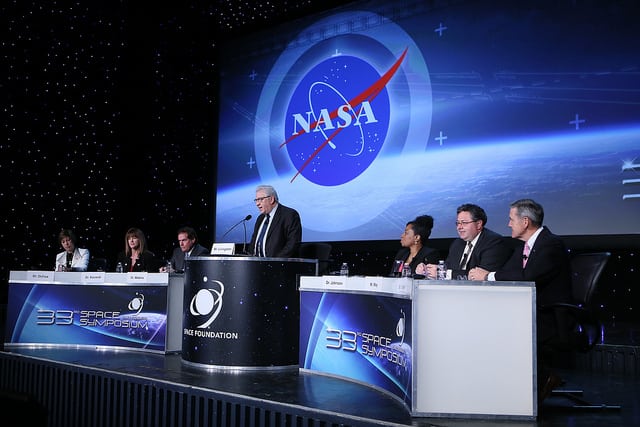Latest News

NASA Directors panel at 33rd Space Symposium. Photo: Space Foundation.
Reconstruction of Launch Pad 39B should be completed by August, said Kennedy Space Center Director Robert Cabana at the 33rd Space Symposium in Colorado Springs, Colorado last week. Furthermore, after the pad is back in operation, Cabana said NASA hopes to support up to 45 launches a year from the cape.
Most of the activity will come from commercial launch providers such as SpaceX, which has already launched three successful missions from the Center despite delays stemming from its launch failure last year. Most recently, SpaceX marked a milestone by successfully lifting SES 10 into orbit atop a flight-proven Falcon 9.
As a whole, the launch industry is working to return to form after a number of prominent setbacks, including Arianespace’s inability to launch from French Guiana due to labor protests. Fortunately, the lineup of NASA directors at the panel seemed optimistic that launch rates will only tick higher as new entrants into the industry, such as Blue Origin, finalize their rocket designs and establish a customer base.
NASA is particularly interested in supporting these commercial endeavors, Cabana said. “In all of history, three nations have sent humans to space. Today, there are four U.S. companies with facilities at Kennedy building hardware to send humans to space,” he said, referring to SpaceX, Boeing, Lockheed Martin and United Paradyne. “Public-private Partnerships (PPPs) work,” he added.
Cabana stated he does not believe it is a matter of government programs versus commercial programs — rather, the U.S. space industry needs to fully integrate both in order to be successful. “I think you’re going to see a continual push to enable commercial operations … We’re working very well with the Air Force and the Federal Aviation Administration (FAA) to make this happen,” he said.
According to Ellen Ochoa, director of the Johnson Space Center, NASA has leaned heavily on the commercial sector for some of its latest projects. “One example of that is the hundreds of suppliers that Orion and the Space Launch System (SLS) use all across the country, including many small business that are capable of providing aerospace grade parts,” she said. However, Ochoa noted that NASA’s support of commercialization isn’t just limited to launch. She said the agency will continue to invest in both foreign and domestic companies researching new technologies across the industry, such as with its Small Business Innovation Research (SBIR) program. “We’re particularly looking for technology that we know fits in our deep space exploration plans,” she said, which includes “infrastructure in the lunar vicinity.” Ochoa also said she expects to see continued commercialization of Low Earth Orbit (LEO), which would take the form of additional use of commercial services for the International Space Station (ISS). “We’re trying to be open-minded,” she said.
Despite the political tension underpinning the relationship between the United States and Russia, the space agencies of both countries have collaborated smoothly on ISS research projects until now. Russia especially seems keen to continue that partnership, as Rocosmos Director General Igor Komarov told reporters at the 33rd Space Symposium that the Russian agency is even willing to consider operating the station for an additional four years after its current retirement date of 2024. However, whether NASA can or will allocate funds to do the same is still a question mark.
As it stands, the NASA advisory committee is musing over a plan that would entirely withdraw the agency’s contributions to the ISS, an annual total of $3 billion, in order to fund development of the Deep Space Gateway. It’s likely the decision will remain up in the air until President Trump selects a new head of NASA. “At this point in time we really don’t know what the final verdict is going to be,” said Christyl Johnson, deputy director for technology and research investments at Goddard Space Flight Center.
Fortunately, despite staggering fiscal blows to other organizations such as the Environmental Protection Agency (EPA), the new administration’s budget proposes just a 1 percent cut to NASA’s funding.
In the meantime, NASA is working to upgrade its ground facilities to ensure it is prepared for this next major stage of space exploration. Cabana said the Kennedy Space Center is tearing down three costly older buildings and constructing a new headquarters, which will save $6 million a year in operating expenses. Glenn Research Center Director Janet Kavandi said Glenn will be making similar refurbishments. “We are trying to ensure we are not duplicating capabilities across the centers,” she said.
Get the latest Via Satellite news!
Subscribe Now